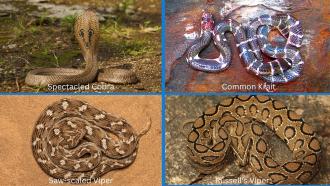
In India, approximately 50,000 deaths are due to snake bites. The Indian krait is undoubtedly the deadliest of all venomous snakes in the country. The shiny, black, meter-long snake with white stripes on its body possesses the most lethal concoction of poisons. A few drops of it can kill a person in a few hours.
For treating a snake-bite victim, it is vital to identify which snake caused the bite to administer the correct, snake-specific antivenom in the crucial few hours after the bite. When the snake is not known, doctors need to test the victim’s blood sample with snake-specific antibodies. These antibodies need to stored at cold temperatures and sometimes cause misdiagnosis.
In a study, a multi-institute research team, led by the Translational Health Science and Technology Institute (THSTI), Faridabad, have designed a synthetic antivenom with a nucleic acid aptamer. It can diagnose Indian krait bites accurately and effectively. A nucleic acid or DNA aptamer is a DNA sequence, which folds itself into a structure that mimics a protein, and may contain loops like a ribbon tied over a gift box. The study, published in the journal Scientific Reports, was funded by THSTI and the Department of Biotechnology through the Innovative Young Biotechnologist Award to Dr Tarun Kumar Sharma.
Antivenoms are antibodies obtained by animals like horses by injecting a small dose of snake venoms. After a few weeks, the antibodies produced in the animal are extracted and purified from their blood. They need to be stored at low temperatures—a convenience not always available in remote public health care centres. Aptamers, on the other hand, are chemically very different from antibodies and can be stored at room temperature. Besides, they have specific reactivity against specific snake venom, unlike antibodies.
Antibodies can also act as antivenoms. Animals produce polyspecific antibodies and a mixture of venoms of the ‘Big Four’—cobra, krait, Russell’s viper and saw-scaled viper—are injected to them to produce antibodies. Most of the snake-bite deaths in India occur due to one of the ‘Big Four’. In the event of a snake bite, such antibodies are administered to the victims, and one of them will bind and neutralise its target venom. For instance, krait antibodies neutralise krait venom, and the other three antibodies remain free in the bloodstream. They often cause side effects like skin rash, serum sickness and sometimes fatal allergic reactions. There is also the ethical concern of putting animals under duress to produce antibodies to be used in humans.
“The development of aptamer does not require animals. Being a synthetic molecule, it does not show any batch-to-batch variation. It can be stored at room temperature and can easily be added with various chemical groups to make it more efficient in its action,” says Dr Sharma. He works at THSTI and has led the effort to design the aptamer.
Bungarotoxin is the most common toxin found in the venoms of Kraits spread across India, South East Asia and East Asian Islands. It causes paralysis, respiratory failure and eventually, death of the victim. The researchers of the current study compared the composition of bungarotoxin of Bungarus multicinctus (Chinese krait), a krait species found in South East Asia, with Indian kraits. They found that it had a high degree of similarity (80%) with bungarotoxin of the Indian krait, Bungarus caeruleus. The aptamer to detect bungarotoxin of Bungarus multicinctus already exists.
The researchers reasoned that since the toxins were similar, the aptamer designed to diagnose B. multicinctus bites could also work for B. caeruleus bites. They observed that only a part of the original aptamer was necessary for its functioning. They tweaked the molecular design of the DNA aptamer to have just one loop instead of the two found in the parent structure. The truncation was not only sufficient to bind to the toxin but was also efficient than its parent aptamer. The short aptamer detected small quantities of venom and attached only to bungarotoxin, avoiding cross reactivity.
The study is a proof of concept that the aptamer designed for one species can be used for another species when the toxins are similar.
“The aptamers can be used for both diagnostics and treatment as antivenom. We have not yet explored their antivenom potential,” says Dr Sharma.
The researchers aim to develop a diagnostic kit that can detect snake bite at a species level. It can then be used by clinicians to decide the dose of specific antivenom to be administered based on the snake bite. Dr Sharma hopes that their findings may allow clinicians to treat patients using evidence-based diagnostics. His group is also making an effort to develop novel aptamers for Indian Krait venom and venom of other snake species as well.
“If it comes in clinical practice, it may certainly reduce the overall treatment cost with better efficacy and no severe side effects of treatment, ” he concludes.
This article has been run past the researchers, whose work is covered, to ensure accuracy.
Editor's Note: The title of the story was changed based on the feedback by the researchers. The error is regretted.






